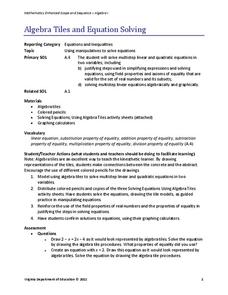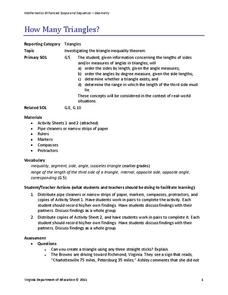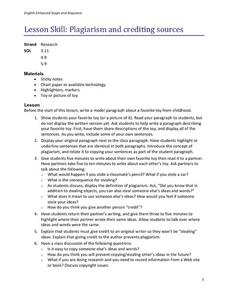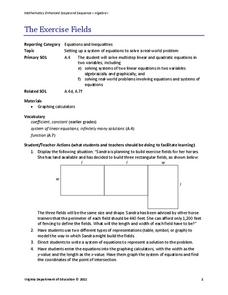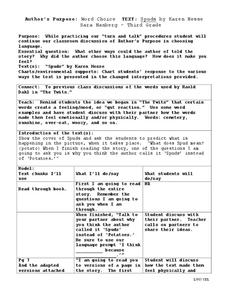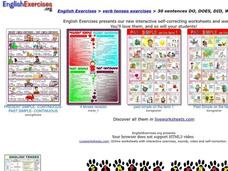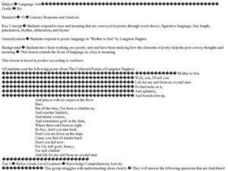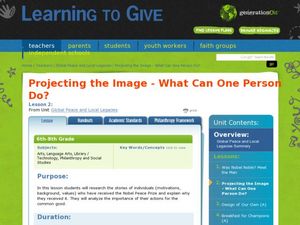Virginia Department of Education
Functions 2
Demonstrate linear and quadratic functions through contextual modeling. Young mathematicians explore both types of functions by analyzing their key features. They then relate these key features to the contextual relationship the function...
Virginia Department of Education
Inductive and Deductive Reasoning
Introduce pupils to the two types of reasoning, inductive and deductive. Classmates work in pairs or small groups to learn the difference between the two and apply these reasonings to develop valid conclusions.
Curated OER
Reference Materials
After a class discussion where kids share how they find answers to their questions, learners explore the world of reference materials such as, an atlas, an almanac, and an encyclopedia. The Internet is also discussed as a way to access...
Virginia Department of Education
Determining Purpose and Audience
Build the writing skills of your junior high wordsmiths with activities that introduce many essential skills of writing. As a class, they develop working definitions of formal vs. informal writing, explore different categories of...
Virginia Department of Education
Algebra Tiles and Solving Equations
Young mathematicians solve linear equations by drawing models of algebra tiles using colored pencils. To finish, they solve the same equations algebraically and check their answers using a graphing calculator.
Virginia Department of Education
How Many Triangles?
Something for young mathematicians to remember: the sum of any two sides must be greater than the third. Class members investigates the Triangle Inequality Theorem to find the relationship between the sides of a triangle. At the...
Curated OER
Plagarism and Crediting Sources
Before the lesson begins, the teacher writes a paragraph about a favorite toy from his/her childhood. The paragraph is read to the class, and each of the sentences are closely looked at for details and support of the topic sentence....
Virginia Department of Education
The Exercise Fields
Horses need exercise, too. Scholars create linear equations to model the perimeter of exercise fields for horses. They finish by solving their equations for the length and width of the fields.
Curated OER
Selfless Service and The Giving Tree - Building Ethical Conscience
Upper elementary schoolers investigate philanthropy and selflessness by reading a children's book. In this ethics lesson plan, they read The Giving Tree by Shel Silverstein, and research Mahatma Gandhi's troublesome, yet inspiring, life....
Smith Family Home
Transportation
Here's an interesting lesson plan that combines elements of language arts, sociology, and a study of the many ways that people use transportation to get from one place to another. The eight-page plan includes worksheets and a word search...
Curated OER
Reading Comprehension
In this reading comprehension lesson, 3rd graders read the story Treasury of Literature and complete various comprehension activities. Students answer factual questions about the story, analyze the story using a bubble map, and...
Curated OER
Word Purpose
Third graders chunk text while reading it. In this language arts lesson, 3rd graders determine the author's purpose for calling certain things the names they are called like spuds for potatoes. Students discuss how words affect the...
Curated OER
ESL: Practice Tag Questions
Use this resource with your kids learning English as their second language. They read the short description of tag questions before attempting to complete 10 themselves.
Curated OER
English Exercises: Verb Tenses Exercises
In this online interactive English worksheet, students respond to 30 multiple choice questions that require them to use verb tenses appropriately. Students may submit their answers to be scored.
Curated OER
Walk Two Moons Chapter 41: The Overlook and Chapter 42: The Bus and The Willow
In this Walk Two Moons comprehension check worksheet, students respond to 15 short answer questions covering chapters 41-42 of Walk Two Moons by Sharon Creech in order to help them better understand the novel.
Curated OER
Touching Spirit Bear: Chapters 19 & 20
In this Touching Spirit Bear comprehension check worksheet, students respond to seventeen short answer questions covering chapters nineteen and twenty of Touching Spirit Bear by Ben Mikaelsen in order to help them better understand the...
Curated OER
Auxiliary Verbs and the Verb To Be in Questions
There are 10 questions for this simple auxiliary verb worksheet. Each question has three multiple choice answers provided, and learners must choose the word that correctly fits in the blank provided.
Curated OER
Poetry language in "Mother to Son"
Sixth graders respond to poetry. In this poetry lesson, 6th graders read the "Mother to Son" by Langston Hughes and they are split into 3 groups for below, at and above grade level. Each group has a different activity to show...
Curated OER
Philanthropy: What Is It?
Learners explore the concept of philanthropy. In this service learning lesson, students hear stories of philanthropists, discuss what philanthropy is, and create a philanthropy poster.
Curated OER
Koala Lou
First graders predict what will happen in different parts of the story Koala Louby Mem Fox. In this predictions lesson plan, 1st graders say and write their predictions.
Curated OER
Arguments Against Ratifying the Constitution
Students define federalism, Federalist, and Anti-Federalist, debate issue of ratification in classroom convention, and take vote on whether to add bill of rights. Three lessons on one page.
Curated OER
Global Peace and Local Legacies
Students research the stories of individuals who have received the Nobel Peace Prize. In this global peace lesson, students describe the work of various winners of the Noble Peace Prize, and analyze the choices made by the recipients and...
Curated OER
Writing Lesson
Fourth graders connect oral language to written language. They practice strategies for overcoming the fear of writing. They practice prewriting strategies and practice writing descriptive paragraphs.
Curated OER
I, Robot by Isaac Asimov
Students contemplate the questions raised by the book/movie I, Robot. For this theoretical physics lesson, students consider the pros and cons as well as the possibility of robots that can think.




